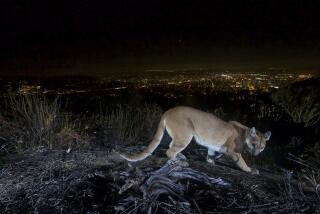This Birdie Isn’t Par for the Course
One side was trying to nail a bird. The other was trying to nail some birdies.
That was the clash of cultures in Pasadena when a giant bird swooped in to drive a wedge between bickering bird-watchers and gung-ho golfers.
With snowy feathers, a long, graceful neck and an affinity for water, the bird seemed to be a swan. But what kind? A rare tundra? A rarer trumpeter? An unwanted mute?
For days, bird-watchers couldn’t get close enough to tell after the swan took up residence in the middle of busy Brookside Golf Course.
They could catch fleeting glimpses of it making short flights around the Arroyo Seco north of the Rose Bowl. So some began sneaking onto the course, which is barred to non-golfers for safety reasons.
Golfers, meantime, began viewing encroaching birders as the course’s newest hazard. Jokes about bird bonking and swan stew began flying like driving-range balls.
The ID mystery ended when Friday’s rainstorm drove golfers off the course and three amateur ornithologists were allowed to cross fairways and greens to watch the swan feed, preen and swim around Brookside’s main lake.
With its “pale spot at the base of the bill suggesting the soon-to-be-yellow loral spot” and “the steep (nearly vertical) slope of the demarcation line between the bill and the feathering on the side of the face,” it was clearly a juvenile tundra swan -- which usually does not venture into Southern California, birders Jon Feenstra, Ron Cyger and Mike San Miguel decided.
Their report, posted on an Internet message site used by Los Angeles birders, seems to have finally put to rest the debate that had feathers flying after the swan’s discovery Jan. 25.
For days the site burned with sometimes passionate disagreement over the swan’s plumage and lineage -- and over the tricky job of getting close enough to the bird to actually see it.
Speculation that it was a trumpeter had evaporated last week when Steve Sosensky and three other birders managed to get a look at the bird’s beak.
The tundra “tends to have the nostril about halfway between the tip of the bill and gape, while for trumpeter it tends to be about halfway between the tip of the bill and the eye,” Sosensky reported. “On the Brookside swan, the nostril is a fit for tundra.”
The mute swan vs. tundra swan conundrum proved more difficult to resolve.
To bird experts, the identity question was important. Mute swans, aggressive and often antagonistic, have become a nuisance in parts of the East Coast. Some ecologists say they interfere with the nesting of other waterfowl and damage aquatic vegetation.
Birder Thomas Wurster identified it as a mute. “It carried its neck and head in a graceful curve with bill tip down,” and it “held its folded wings loosely raised over its back,” moves that are typical of the mute swan, he wrote on the message board.
Kimball Garrett, an ornithologist with the Los Angeles County Natural History Museum, disagreed. “This points out the danger of using posture, wing elevation and neck curvature in identifying actively foraging swans,” he said. Garrett also warned against trespassing at the golf course.
That prompted a retort from Thomas Miko, who complained of what he called “groupthink” among bird-watchers. “Hey, if everybody else says it’s a tundra swan, it must be a tundra swan, so I don’t need to critically study the bird.”
Miko, who had earlier reported on entering Brookside and encountering golfers who had “flushed” out the swan, defended that visit. “ ... I DID NOT go marching defiantly onto the greens of Brookside last Friday night like Sherman in Atlanta, brushing golfers aside like so much flotsam,” he wrote.
At Brookside, meantime, the swan was taking the discord in stride. Not to mention the golf balls raining down around it on the lake between Course 1’s sixth fairway and Course 2’s fourth fairway. About 400 golfers each day pass the lake, installed in the 76-year-old course -- adjacent to the Rose Bowl -- for the 1968 Los Angeles Open.
“I was a little worried when my ball landed in the water 10 feet from it,” said Greg Soltis, visiting from Cleveland on business.
“It was very impressive. It had its wings out like it was ready to charge. I was so busy looking at the swan that I shanked my next shot.”
A few foursomes behind, Phillip Ramirez of Altadena joked about the bird’s size. “I’m gonna go get my gun,” he said with a grin, quickly adding: “Birds like that are unique. They need to be protected.”
Ramirez’s buddies roared. “Next you’re going say you’re a member of PETA and a vegetarian,” one laughed.
The swan may stay at Brookside as long as it wants, said David Sams, director of golf operations for the Rose Bowl. Birds rarely get hit by flying balls, he said.
“Well, maybe it’s not that rare,” Sams said, correcting himself. “The swan’s staying in the lake. And that’s where everybody hits their balls.”
And a direct hit from a Titleist or Top-Flite near that yellow loral spot could be this tundra’s swan song.
More to Read
Sign up for The Wild
We’ll help you find the best places to hike, bike and run, as well as the perfect silent spots for meditation and yoga.
You may occasionally receive promotional content from the Los Angeles Times.







